Fig. 1
Epidermal nevus on the right thumb presenting as a linear, tan plaque (By permission of Mayo Foundation for Medical Education and Research. All rights reserved)
Epidermal nevi are most commonly solitary and small with no other associations, but extensive epidermal nevi may be a marker of a variety of syndromes, including epidermal nevus syndrome (epidermal nevi with associated extracutaneous features) (Figs. 2 and 3). Central nervous system, ocular, and skeletal anomalies can occur in the group of epidermal nevus syndromes. Skeletal lesions that have been reported include scoliosis and incomplete formation or hypoplasia of various long bones of the extremities (Schachner and Hansen 2011). Thickening and darkening of epidermal nevi generally occur around puberty, resulting in a verrucous-appearing plaque (Brandling-Bennett and Morel 2010).



Fig. 2
Epidermal nevus on the left palm, presenting as a linear, verrucous, hyperkeratotic plaque in the setting of epidermal nevus syndrome (By permission of Mayo Foundation for Medical Education and Research. All rights reserved)

Fig. 3
Epidermal nevus syndrome demonstrates a whorled/blaschkoid pattern on the left shoulder region. Note the characteristic thickening and darkening that have occurred in the neck region with age (By permission of Mayo Foundation for Medical Education and Research. All rights reserved)
Hyperkeratosis and papillomatosis are seen on histopathology, but these are not specific findings. However, if epidermolytic hyperkeratosis is present histopathologically, this is an important finding as it may indicate a risk of transmitting the genetic syndrome of widespread epidermolytic hyperkeratosis/bullous congenital ichthyosiform erythroderma to the patient’s offspring, which is a systemic defect in keratin 1/keratin 10 (Paller et al. 1994; Tsubota et al. 2007).
There is a negligible risk of malignant transformation; therefore, treatment of epidermal nevi is not necessary unless the lesions involve cosmetically important areas. Excision is curative, but often not easily completed due to the linear or whorled configuration of epidermal nevi. Risks of excision should be discussed with the patient/family, including spreading, contracture, or hypertrophy of the resultant scars. Other superficially destructive measures have been used including dermabrasion, curettage, cryotherapy, and laser therapy. These treatments may help initially, but the lesions will frequently recur. Carbon dioxide (CO2) laser may be a helpful treatment modality; however, it also has a potential risk of scarring (Brandling-Bennett and Morel 2010) .
Epidermal Neoplasms: Acquired
Cutaneous Warts
Cutaneous warts, verrucae, are caused by human papillomavirus infection of the epidermis and are divided into flat/plane warts (V. plana) and common warts (V. vulgaris) which includes periungual/subungual warts (Fig. 4).
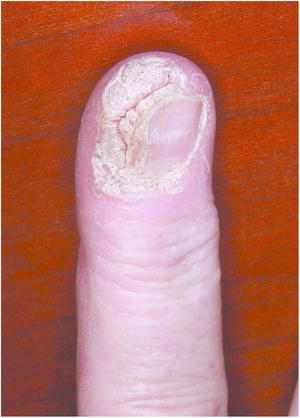

Fig. 4
Periungual wart (By permission of Mayo Foundation for Medical Education and Research. All rights reserved)
Common warts make up the majority of verrucae and occur as isolated or grouped papules or may coalesce to form a large plaque. Verrucae vulgaris clinically presents with significant hyperkeratosis resulting in a cauliflower-like irregular rough surface, and often tiny “black dots” may be visible which represent thrombosed capillaries within the lesion (Fig. 5).
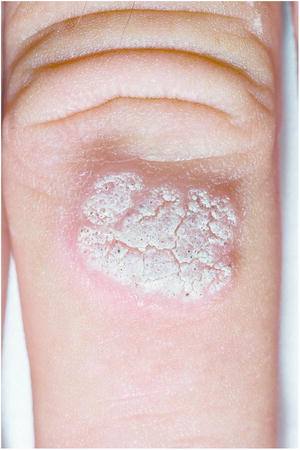

Fig. 5
Verrucous wart presenting with a well-demarcated, hyperkeratotic, plaque on the dorsal finger. Note the black dots which represent thrombosed capillaries (By permission of Mayo Foundation for Medical Education and Research. All rights reserved)
Gently paring the hyperkeratosis with a #15 blade scalpel will make the capillaries more prominent and may be used to aid in diagnosis. Additionally, warts do not have dermatoglyphics (fingerprint folds), as opposed to calluses in which these lines are accentuated.
In contrast, flat warts are less common and present as smaller, minimally elevated, smooth-topped papules. Often, multiple lesions are present, and they are frequently in a linear configuration due to koebnerization (local trauma inducing more lesions) (Fig. 6).
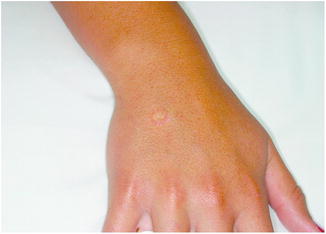

Fig. 6
Flat warts/verruca plana presenting as coalescing, minimally elevated, flat-topped papules on the dorsal hand (By permission of Mayo Foundation for Medical Education and Research. All rights reserved)
Transmission of all types of warts occurs by skin-to-skin contact with an infected individual or by self-inoculation, with the incubation period occurring over 1–6 months. Once clinically developed, the majority of warts undergo spontaneous resolution within 2 years; however, they may be present for over 5 years (McLaughlin and Shafritz 2011). During this time, local tissue alteration is possible, and further transmission may occur. Therefore, attempts at eradication are typically made. Destructive measures including cryotherapy with liquid nitrogen using a spray device or a cotton swab are most often used in clinical practice. Pulsed dye laser therapy is another destructive measure with a similar efficacy. Alternatively, various topical treatments may also be effective, including salicylic acid, imiquimod, 5-fluorouracil, cantharidin, and immunotherapy. Salicylic acid has substantial published evidence demonstrating significant efficacy (Gibbs et al. 2002). Salicylic acid is a well-tolerated, affordable, over-the-counter, keratolytic agent. Home treatment options include gentle debridement using a pumice stone and applying duct tape for simple occlusion of the lesion. It is important to avoid contact with unaffected areas of the skin to limit the possibility of self-inoculation. Regardless of therapy, warts frequently take multiple weeks to months of treatment to be cured.
Warts have a potential (overall rare) risk of transforming into squamous cell carcinoma, especially in immunosuppressed individuals. For any lesion that has concerning clinical features (steady or rapid growth, pain, ulceration, recalcitrant to standard therapies), a biopsy or excision should be considered for pathologic evaluation .
Molluscum Contagiosum
Molluscum contagiosum is a poxvirus that results in multiple, skin-colored to erythematous, pearly papules with an umbilicated center (Fig. 7).


Fig. 7
Molluscum contagiosum presents as skin-colored, umbilicated, pearly papules (By permission of Mayo Foundation for Medical Education and Research. All rights reserved)
Molluscum typically affects school-age children and is transmitted through close physical contact. Immunocompetent adults do not typically develop molluscum even if exposed to the virus. Molluscum often presents with clustered lesions as the result of autoinoculation of the virus, though it may occur in any distribution. Ten to twenty papules are often present in immunocompetent individuals, whereas hundreds of lesions have been reported in immunocompromised patients. Numerous lesions are also commonly found when patients have atopic dermatitis (Brown et al. 2006). Each lesion takes a few weeks to months to heal, during which time the lesion can become erythematous and inflamed. Parents will often seek medical attention at this point, believing the lesions are infected, but this inflammatory response indicates immune recognition and that the lesion will likely soon self-resolve (Coloe et al. 2009).
Treatment is not necessary, as molluscum infection will eventually spontaneously resolve. However, this may occur over a 6-month to 4-year period. Therefore, it is often difficult for physicians and parents to decide whether to treat the infection. Destructive methods including curettage, cryotherapy, cantharidin, and needle pricking are the most common treatments used (Hanna et al. 2006). It is important to recognize that these treatments can be painful for the child and may lead to scarring, including hyperpigmentation or hypopigmentation at the site of treatment. Topical therapies including retinoids, imiquimod, and salicylic acid may also be considered, realizing that these topicals can also result in significant skin irritation and inflammation .
Poroma
Eccrine poroma has a characteristic clinical presentation of a macerated, red papule with an epidermal collarette (Fig. 8).


Fig. 8
Eccrine poroma presents as a papule with a characteristic collarette on the thumb (By permission of Mayo Foundation for Medical Education and Research. All rights reserved)
However, clinicians often mistake these lesions for another diagnosis such as pyogenic granuloma, hemangioma, fibroma, or verruca. The majority of poromas present on the extremities, with these lesions occurring most commonly on the palm of the hand or the sole of the foot. However, poromas may occur on any cutaneous surface (Chen et al. 2006). A rare variant is eccrine poromatosis, in which numerous lesions are seen on the palms and soles in the genetic syndrome hidrotic ectodermal dysplasia.
The histopathology of poroma demonstrates an intraepidermal collection of small monotonous cells that are sharply marginated from the adjacent keratinocytes. There are three subtypes depending on the amount of epidermal and dermal involvement: hidroacanthoma simplex (only epidermal), poroma (both epidermal and dermal), and dermal duct tumor (only dermal). Malignant evolution into porocarcinoma has been described but is rare overall. Simple excision is the typical treatment of benign poroma .
Melanocytic Neoplasms: Congenital/Infantile
Melanocytic nevi are benign cutaneous proliferations of melanocytes and are divided into two major subgroups: congenital nevi and acquired nevi. Congenital nevi are classified based on size (small, medium, and large/giant), whereas acquired nevi are classified based on the histopathologic findings (common, Spitz, blue, combined, and atypical/dysplastic). Malignant melanoma can develop within nevi, and this risk correlates with a larger size of congenital nevi and an increased number of acquired nevi.
Congenital Melanocytic Nevi
Congenital melanocytic nevi (CMNs) are present at birth or arise within the first few months of life. Size is widely variable, and traditionally CMNs have been classified as “small” (<1.5 cm), “medium” (1.5–19.9 cm), and “large” or “giant” (>20 cm). These measurements are based on final size, so in neonates giant CMNs may alternatively be defined as being larger than the size of the palm of the baby at birth (approximately 6 cm) (Schachner and Hansen 2011). Approximately 40 % of CMNs affect the extremities, and 10 % involve the hands or feet (Figs. 9 and 10; Alikhan et al. 2012).
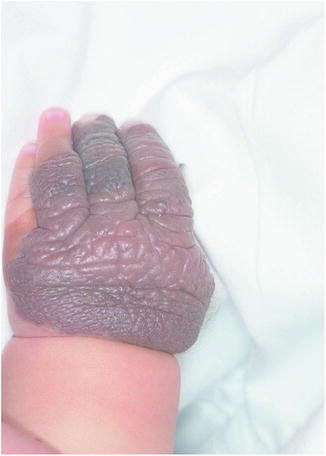
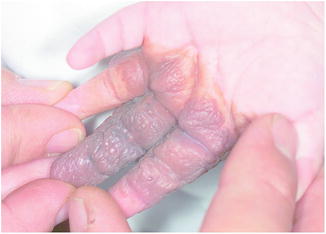

Fig. 9
Congenital melanocytic nevus involving the dorsal left hand and fingers (By permission of Mayo Foundation for Medical Education and Research. All rights reserved)

Fig. 10
Congenital melanocytic nevus involving the volar left hand and fingers (By permission of Mayo Foundation for Medical Education and Research. All rights reserved)
CMNs may begin as flat tan patches resembling café au lait macules (Fig. 11) but will generally darken and become elevated with time.
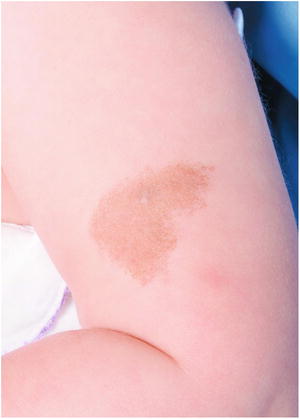

Fig. 11
Congenital melanocytic nevus may present as a flat, tan patch resembling a cafe au lait macule, as seen here on the left arm (By permission of Mayo Foundation for Medical Education and Research. All rights reserved)
In addition, CMNs may develop small dark macules or papules within them (Fig. 12).
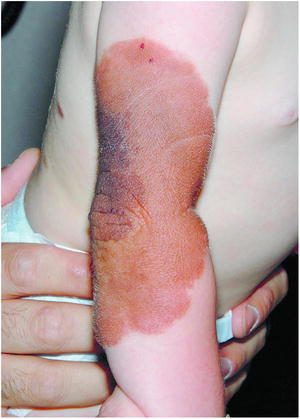

Fig. 12
Congenital melanocytic nevus on the right elbow region, which demonstrates darker papules within the lesion (By permission of Mayo Foundation for Medical Education and Research. All rights reserved)
With age, verrucous changes and overlying hypertrichosis are common (Fig. 13).
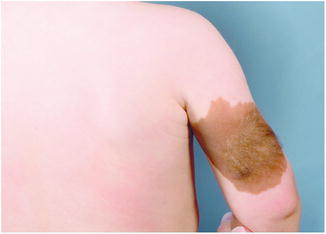

Fig. 13
Congenital melanocytic nevus on the right posterior arm with overlying hypertrichosis (By permission of Mayo Foundation for Medical Education and Research. All rights reserved)
Melanoma is the most common malignancy to develop within CMNs. Traditionally, the risk of melanoma has correlated to the size of the CMN. Small and medium CMNs have been shown to have an incidence of melanoma of less than 1 % in most studies. The risk of melanoma in large or giant CMNs is much more significant, with the reported frequency at approximately 2–3 % (Alikhan et al. 2012). Higher risk is correlated with an increased diameter of the lesion and increasing number of satellite nevi. Most CMN-associated melanoma occurs during childhood and adolescence. Melanomas in large CMNs most frequently develop deep in the dermis or subcutaneous fat, thereby making early diagnosis challenging. In contrast, melanomas developing in small CMNs usually originate within the epidermis (Schachner and Hansen 2011).
CMNs may also be complicated by neurocutaneous melanosis (NCM), which is central nervous system involvement that can be fatal. Similar to melanoma risk, NCM risk appears to be greater in patients with larger CMN diameter and multiple satellite nevi (Schachner and Hansen 2011). Patients with multiple or giant CMNs should be followed, regardless of prior treatment for the CMNs, in order to screen for NCM. Magnetic resonance imaging (MRI) should be performed if symptomatic evidence of NCM develops. Routine MRI for asymptomatic patients is controversial (Alikhan et al. 2012).
Depending on the clinical features, it is reasonable to consider either observation or complete excision of CMNs. Typically the small and medium lesions are observed, with excision reserved for larger or changing lesions. Biopsy or excision is always recommended when a history of changes in the nevus is present or there are clinically worrisome features (Fig. 14).
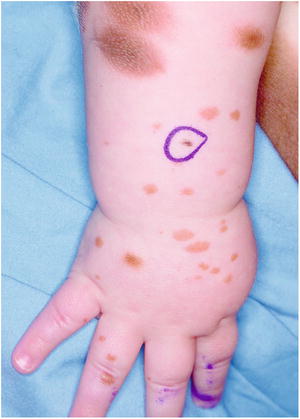

Fig. 14
Multiple congenital melanocytic nevi on the right upper extremity. Biopsy or excision is recommended when clinically worrisome features are present (By permission of Mayo Foundation for Medical Education and Research. All rights reserved)
Discussion of the risks and benefits of excision for giant CMNs is important because complete excision may reduce the incidence of melanoma and improve cosmetic appearance. Staged excision may be beneficial for large CMNs. If complete resection is not feasible, partial-thickness and abrasive removal procedures (dermatome shaving, curettage, dermabrasion, laser therapy) may be considered to improve cosmesis, recognizing that this will not remove the deeper dermal nevus cells and thus not considerably decrease the risk of melanoma (Schachner and Hansen 2011).
Melanocytic Neoplasms: Acquired Melanocytic Nevi
Acquired nevi can occur on any area of the body, including the hands and feet, which are often termed acral nevi. Most of these lesions are flat with one to two shades of brown pigmentation, no to slight border irregularity, and well-defined to slightly ill-defined borders (Figs. 15 and 16).
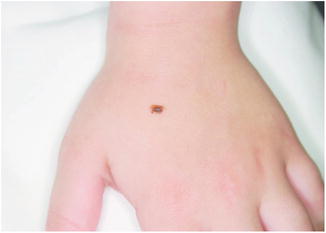


Fig. 15
Acral melanocytic nevus on the dorsal hand, presenting as a well-defined brown papule with only slight border irregularity (By permission of Mayo Foundation for Medical Education and Research. All rights reserved)

Fig. 16
Dermatoscopic image of the acral nevus demonstrating the reticular pigment network (By permission of Mayo Foundation for Medical Education and Research. All rights reserved)
Palmar nevi occur in all skin types, though are more commonly found in patients with more darkly pigmented skin types (Palicka and Rhodes 2010). Due to the dermatoglyphics, palmar nevi most often present with a furrowed and lattice pattern of pigmentation (Fig. 17).
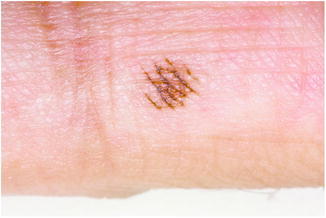

Fig. 17
Palmar nevus with the characteristic pigment pattern accentuated by the dermatoglyphics on the thickened volar skin of the hand (By permission of Mayo Foundation for Medical Education and Research. All rights reserved)
Acral nevi have characteristic histopathologic findings including atypical features of the epidermal component. These atypical features include architectural disorder and a pagetoid growth pattern that can mimic dysplastic nevi and melanoma (Hosler et al. 2008). The pathologist should be cautious not to overdiagnose dysplastic nevi or melanoma on an acral site. Melanoma at acral sites typically has more of a lentiginous pattern as opposed to prominent pagetoid growth and will have notable cytologic atypia. Additionally, acral lentiginous melanoma makes up a higher proportion of melanoma in individuals of darker skin types.
Melanocytic nevi should be monitored for any change in size, color, and shape. If a pigmented lesion has features of melanoma (A, asymmetry; B, border irregularity; C, color variegation; D, diameter >6 mm; E, evolution), biopsy or excision should be performed.
Lentigines
Other skin lesions may clinically appear pigmented owing to increased basal epidermal melanin pigment and/or an increased density of single melanocytes, though are not composed of nested melanocytes such as in melanocytic nevi.
Lentigines are macular hyperpigmented lesions that persist throughout the year, unlike ephelides (freckles), which darken and lighten depending on the amount of sun exposure. They are commonly subclassified as lentigo simplex (simple lentigo) and solar lentigo (actinic lentigo). Lentigo simplex may appear early in childhood and occur on any cutaneous surface, whereas solar lentigo occurs at an older age after chronic sun exposure with a predilection for the face, shoulders, and dorsal hands (Fig. 18).


Fig. 18
Lentigo presenting as a hyperpigmented macule on the forearm (By permission of Mayo Foundation for Medical Education and Research. All rights reserved)
Treatment is not necessary for lentigines; however, they may occasionally be biopsied or excised due to the similar clinical appearance to an atypical nevus or early melanoma. Patients with multiple disseminated lentigines may indicate an associated syndrome such as LEOPARD (lentigines, ECG conduction defects, ocular hypertelorism, pulmonic stenosis, abnormal genitalia, retardation of growth, deafness) syndrome, Peutz-Jeghers syndrome (lentigines, gastrointestinal polyps), or Carney complex (lentigines, blue nevi, myxomas, endocrine neoplasms) .
Dermal Neoplasms: Congenital/Infantile
Connective Tissue Nevi
Connective tissue nevi are benign congenital hamartomas that may present on the upper extremity. They clinically present at birth and typically appear as skin-colored papules coalescing to form cobblestone-like plaques (Fig. 19).
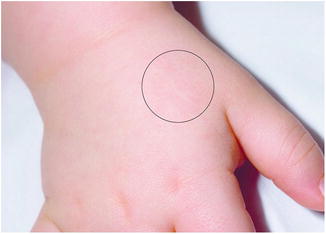

Fig. 19
Connective tissue nevus on the right dorsal hand presenting as a subtle, cobblestoned, skin-colored plaque (By permission of Mayo Foundation for Medical Education and Research. All rights reserved)
Connective tissue nevi are characterized by excess collagen and/or elastin on histopathology. Comparison with a biopsy from adjacent or contralateral normal skin is sometimes helpful, since the histopathologic changes may be subtle. Connective tissue nevi can occur sporadically or in association with several syndromes including tuberous sclerosis, multiple endocrine neoplasia I (MEN-I), Buschke-Ollendorff syndrome, or Proteus syndrome. Treatment is generally not necessary, as these are benign and typically asymptomatic lesions. Surgical resection can be performed if otherwise indicated; however, it may be difficult to determine whether the margins are clear because these lesions are typically poorly defined (Schachner and Hansen 2011).
Infantile Digital Fibromatosis
Infantile digital fibromatosis (IDF) is a congenital tumor that typically presents as enlarging, firm, erythematous to skin-colored nodules along the sides of the digits (Fig. 20). About 30 % of these lesions are present at birth (Laskin et al. 2009).
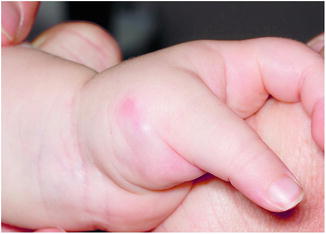

Fig. 20
Infantile digital fibromatosis presents has a firm, red to skin-colored mass at the base of the digit (By permission of Mayo Foundation for Medical Education and Research. All rights reserved)
A nodular dermal proliferation of spindled myofibroblasts is present on histopathology. Eosinophilic paranuclear cytoplasmic inclusions are pathognomonic for IDF and may be demonstrated with a Masson trichrome stain. These tumors may involute spontaneously; however, the likelihood of this is not well understood. Malignant transformation or metastases do not occur. Surgery may be considered for cases of progressive enlargement to minimize potential deformity. However, local recurrence rates following surgical resection may be as high as 50–60 %. Rapid growth may increase concern and prompt surgical intervention, particularly with the development of functional impairment. The use of Mohs micrographic surgery for removal of IDF has been reported (Campbell and Petrick 2007). Intralesional corticosteroids have also been shown to reduce lesion size and associated symptoms but with a recurrence rate similar to that of surgical excision (Holmes et al. 2011). Regression of IDF with monthly intralesional injections of fluorouracil has also been reported (Oh et al. 2005) .
Myofibroma
Infantile myofibromatosis is one of the most common benign neonatal tumors. The upper extremities are commonly affected, second only to the head and neck region. Lesions may be solitary or multiple, and it is important to note that when myofibromas are multicentric, they may have underlying visceral involvement (Netscher et al. 2009). Multiple myofibromas occur more frequently in females (Schachner and Hansen 2011).
Solitary myofibromas present as firm subcutaneous masses (Fig. 21) that can later regress to leave atrophic patches.
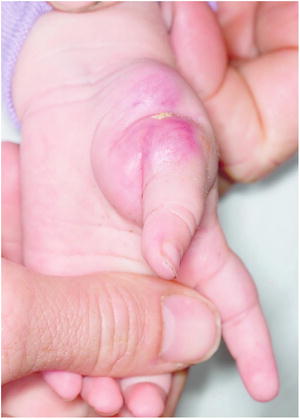

Fig. 21
Myofibroma presents as a subcutaneous mass at the base of the left thumb (By permission of Mayo Foundation for Medical Education and Research. All rights reserved)
Myofibromatosis presents as infiltrating plaques that can ulcerate or have associated digital contractures. Despite being benign, visceral involvement carries a poor prognosis. However, in the absence of visceral involvement, infantile myofibromatosis often spontaneously resolves without consequence.
On histopathology, a peripheral zone of spindled cells forming fascicles surrounds a central zone of round or polygonal cells forming sheets. The spindled cells are smooth muscle actin positive but negative for desmin.
Solitary myofibromas may be observed, given their propensity to spontaneously resolve. Symptomatic or functionally impairing tumors should be excised. A stepwise surgical approach may be required, where incomplete resection is performed with the goal of resolving the fibrosing complications while preserving normal anatomical structures. This is reasonable since the residual tumor may thereafter spontaneously resolve (Netscher et al. 2009).
Dermal Neoplasms: Acquired
Juvenile Xanthogranuloma
Juvenile xanthogranuloma (JXG) is classified as a benign non-Langerhans cell histiocytosis. Involvement of the head and neck and trunk is the most common, although approximately 8 % occur on the upper extremities (Liu et al. 2005). JXG clinically presents as an asymptomatic, yellow-brown, papule (Fig. 22).
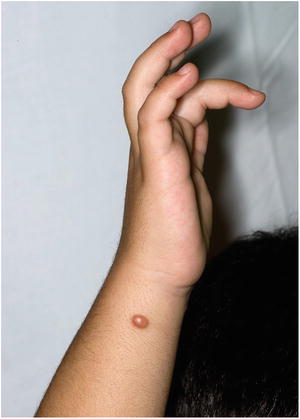

Fig. 22
Juvenile xanthogranuloma presents as a yellow-brown papule on the right distal forearm (By permission of Mayo Foundation for Medical Education and Research. All rights reserved)
JXG can uncommonly involve the nail unit including the nail bed and may present as subungual nodules with associated nail dystrophy (Piraccini et al. 2003). Rarely, patients may have a concurrent systemic histiocytic disease with involvement of the brain or visceral organs (Liu et al. 2005). Association with café au lait macules, neurofibromatosis, and childhood leukemia has been reported (Raygada et al. 2010). Histopathology shows sheets of xanthomatized histiocytes and Touton giant cells. The typical histopathologic changes may not be present in early lesions, and immunohistochemistry may be needed to differentiate JXG (S100 and CD1a negative) from Langerhans cell histiocytosis. JXG will typically regress within 2–6 years without treatment. However, if clinically indicated, simple excision is curative .
Angiofibroma
Acquired digital fibrokeratoma is classified as a type of angiofibroma that most commonly occurs on the fingers and toes. The typical clinical presentation is an elongated papule with a collarette at the base (Fig. 23).


Fig. 23
Acquired digital fibrokeratoma on the dorsal thumb (By permission of Mayo Foundation for Medical Education and Research. All rights reserved)
The differential diagnosis for acquired digital fibrokeratoma includes a wart or supernumerary digit. On histopathology, there is overlying hyperkeratosis with thickened dermal collagen (fibrosis) and increased blood vessels (angioplasia); therefore, it is classified as an angiofibroma. Another type of angiofibroma that can occur on the digits includes the periungual Koenen tumor found in the genetic syndrome tuberous sclerosis. Digital fibrokeratomas are usually easily removed by shave excision.
Dermatofibroma
Dermatofibroma (DF), or cutaneous fibrous histiocytoma, is a very common benign fibrohistiocytic neoplasm involving the dermis and at times the deeper subcutaneous tissue. Dermatofibroma is most frequent on the lower extremities but also commonly occurs on the upper extremities. The hand is not a typical location for DF, but this may occur (Fig. 24; Yamamoto et al. 2003).




